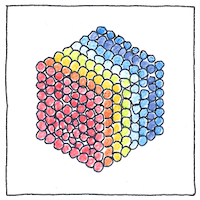Osborne Reynolds,
Martin Knudsen
fluid dynamics

|
Thermal transpiration
Osborne Reynolds explained the behavior of Crookes radiometer, having found that heating a porous plate only on one side moves gas molecules from the cooler to the hotter side. A Knudsen pump moves gas by the same force without moving parts. Gas molecules move from the cooler to the hotter end of a narrow channel.
When molecules abhor
Strangely it seems gas molecules creep from cold to heat through narrow pores as though they abhor crowd and cloud and going alone were allowed.
Leaking pores
Your gas leaks from tiny pores you didn’t even know were there. Helium from your balloon is on its way to outer space. Since entropy is a universal law, you might wonder about all your other leaking pores. But not to worry. Your existence suggests life can yet sustain itself.



Thermal transpiration is enhanced when the average distance that a gas molecule moves between collisions is larger than the dimensions of the channel in which the molecules move, given that the walls of the channel at its entrance are cooler than the walls at its exit.
However, even after all these years, Osborne Reynold’s explanation of the Crookes radiometer is still controversial.
See also in The book of science:
Readings in wikipedia: